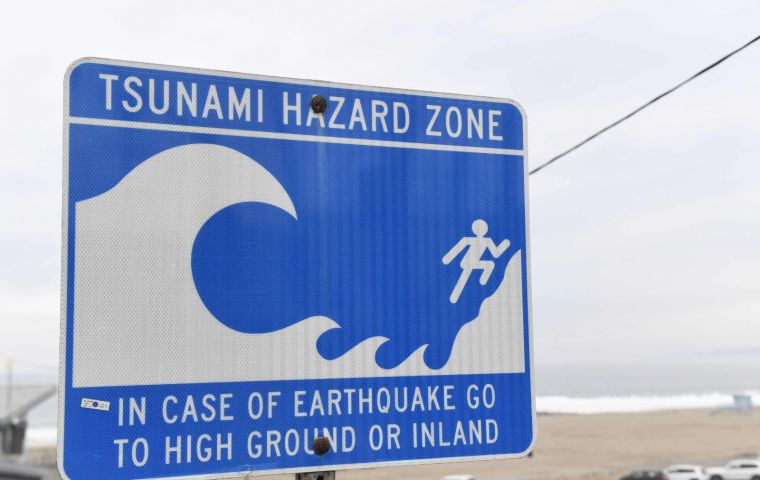MercoPress. South Atlantic News Agency
Tsunami warnings triggered all across Pacific Ocean
 The waves are expected to reach mainland Chile between 1 and 3 pm
The waves are expected to reach mainland Chile between 1 and 3 pm An 8.8-magnitude earthquake off Russia's Kamchatka Peninsula triggered tsunami warnings and alerts across the Pacific. In Chile, the Navy's Hydrographic and Oceanographic Service (SHOA) initially issued a preliminary tsunami warning for the Atacama, Coquimbo, and Valparaíso regions, with a “caution” for the rest of the coast.
However, after a National Disaster Risk Management Committee (Cogrid) meeting, the tsunami warning was extended from Arica and Parinacota to the Los Lagos Region. A state of “caution” was established for the Aysén and Magallanes regions and the Chilean Antarctic territory.
The Pacific Tsunami Warning Center (PTWC) forecast waves of 1 to 3 meters for some coastal areas of Chile.
Undersecretary of the Interior Víctor Ramos clarified that the “alert” status was proportionate to the waves expected, requiring evacuation of the coastline above 30 meters. A “caution” status indicates waves between 30 centimeters and 1 meter, affecting beach areas.
President Gabriel Boric Font urged calm and instructed the public to follow instructions for evacuations, which are typically initiated three hours before the estimated wave arrival. As a precautionary measure, the Ministry of Education suspended classes in all coastal communities from Arica and Parinacota to Los Lagos.
The first waves were expected to reach Easter Island at 9.25 am on Wednesday, with the rest of the country's coast anticipated to see waves shortly before 3 pm.
Peru issued a tsunami warning for its entire coastline. Waves were expected to arrive between 10:10 a.m. and 12:31 p.m. local time on Wednesday, July 30, with estimated heights of 0.84 meters in Callao and 76 centimeters in Pisco.
Ecuador issued a tsunami warning for the Galapagos Islands, leading to the immediate suspension of maritime activities and preventive evacuations of beaches and low-lying areas in the island region. A state of observation was put in place for the mainland coast due to a lower immediate risk.
The earthquake, noted as the sixth strongest ever recorded, caused widespread disruption across the Pacific.
In Russia, a state of emergency was declared in Severo-Kurilsk, near the epicenter, where tsunami waves tore boats from moorings and swept away containers.
In Japan, over 1.9 million people were ordered to evacuate as waves hit the north and east coasts, though major damage was avoided.
In Hawaii, tsunami waves up to 1.5 meters high hit the islands, prompting emergency shelters to open and residents to evacuate coastal areas.
In the mainland United States (West Coast), authorities in California warned residents, ordering evacuations of boats in Moss Landing and using helicopters to issue warnings along the Los Angeles coastline. Nearly 27 million people live in California's coastal counties.
Other countries, such as the Philippines, Indonesia, China, Mexico, Panama, and Taiwan, also issued tsunami advisories, warnings, or watches.




Top Comments
Disclaimer & comment rulesCommenting for this story is now closed.
If you have a Facebook account, become a fan and comment on our Facebook Page!